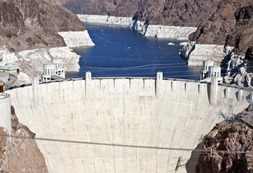Wall Street Discovers Water Shortages Affect the Bottom Line
by David Jay, TRIPLE PUNDIT, October 25, 2010
 Atlanta’s water utility has a serious problem. 40% of the city’s water supply could be cut by 2012 due to the ruling of a federal judge. Across the country, water levels in Lake Mead are dropping so low that the Hoover Dam could be forced to stop generating electricity by 2013.
Atlanta’s water utility has a serious problem. 40% of the city’s water supply could be cut by 2012 due to the ruling of a federal judge. Across the country, water levels in Lake Mead are dropping so low that the Hoover Dam could be forced to stop generating electricity by 2013.
Shockingly, these risk factors have been almost completely ignored by financial markets. Water and power utilities are often funded through municipal bonds, but the rating agencies and investors in charge of valuing and trading those bonds have ignored the water risk poses to their investments. Bonds for utilities in Atlanta and LA were both given high marks, with no mention of how water risk might impact their operations.
Ceres, an organization specializing in sustainability and capital markets, is trying to transform the way that bond markets think about water. In partnership with PriceWaterhouseCoopers and Water Asset Management, Ceres has released a report titled The Ripple Effect: Water Risk In the Municipal Bond Market. The report uses an elaborate quantitative model to estimate the water risk that bond rating agencies and bond investors have been ignoring.
This is great news for anyone looking to address the water crisis. If the $32.1 trillion US bond market realizes that some of those dollars are at risk due to water stress they’ll start looking for ways to mitigate that risk. This will create a strong incentive for utilities to develop strategies to mitigate that risk by reducing demand and protecting watersheds, and it will create an equally strong incentive for investors to fund those strategies.
Where will investors be scrambling for solutions? According to the report, here are a few bonds to keep an eye on:
- The Los Angeles Department of Water & Power’s water system bond received the highest risk score of all water utilities, based on tight restrictions on local water supplies due to environmental regulations and prolonged drought. The municipal system, the nation’s largest, is also highly reliant on vulnerable water imports, including the Colorado River. The utility’s water bond was rated “AA+” and “Aa2” by Fitch and Moody’s, respectively, earlier this year.
- Atlanta’s Water and Sewer System received the second highest water risk score, a direct result of its reliance on one key local water supply whose future is jeopardized by a judicial order that may require the city to reduce its withdrawals by as much as 40 percent in 2012. The utility’s water bond received “A” and “A1” ratings from Fitch and Moody’s, respectively, earlier this year.
- The Phonix and Glendale, AZ utilities—systems with high reliance on increasingly expensive and potentially volatile out-of-state water imports from the Colorado River—also received high water risks scores. The Phoenix bond is rated “AAA” and Glendale bond “AA” by Standard & Poor’s.
- Water risk scores for the Tarrant County, TX utility were double those of the neighboring Dallas system. The wide gap is the result of Tarrant County’s consistent drawdown on critical storage reservoirs to meet water demand, which makes the system more vulnerable to prolonged drought. Both utilities have identical credit ratings.
In order to address this market failure, all of the players involved will have to start taking water more seriously. Utilities will need to become more open and organized about risk disclosure, and more focused on creating solutions for risk mitigation. Bond rating agencies will need to start paying attention both to the water stress that utilities are facing and to how thoroughly they are mobilizing to reduce that stress. [Read rest of story]


